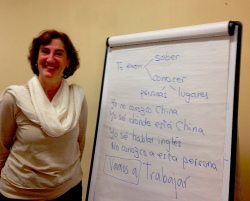
Have you thought about learning a foreign language–as an adult? I initially signed up for a foreign language course out of necessity. Having recently moved to Barcelona, I quickly realized that very few people spoke any English in the outskirts of the city, where we live.
To be able to order pizza and get it delivered to the right address (among many other daily tasks), I was going to need to learn the native tongue.
There was also the increasingly pressing issue of not being able navigate my Spanish Vodofone mobile phone. Because the navigational instructions are in Spanish, I had not been able to retrieve a single voicemail.
Unfortunately, through previous experiences, I had developed a preconceived notion that foreign language instructors are not effective. My German teacher in high school typically had us write the same sentences hundreds of times as the means to the end. In a more recent conversational French class, the teacher took more of an intimidating versus encouraging approach to learning. No need to elaborate on either of these teachers — or their approaches to teaching — other than that they did not work well for me.
From the moment I walked into the historic building in the L’Eixample District, where Senora Montse Bovet teaches, I knew this experience was going to be much different. Yet it was when I boarded the antique glass elevator (reminiscent of Charlie and the Chocolate Factory) and began the ascent up six floors that I knew this experience was also going to be full of unexpected surprises. (This was assuming I didn’t get stuck along the way.)
Senora Montse greeted me with a warm welcome – as did the rest of the class, which included a couple from China, a woman from Hungary, a woman from Israel, and a couple from Connecticut.
While Senora Montse only speaks Spanish in class (and asks us to do the same), she uses such animated gestures that not only do I understand what she is saying, but I find myself completely entertained.
Her approach to teaching is to provide us the vocabulary and the phrases that we need for real-world situations– from start to finish. For example, in addition to the words that would be useful to order lunch, she also gives us the dialogue we need to make a reservation over phone, as well as how to ask for our check at the end of the meal. In addition, she offers some insight into what is culturally appropriate for “la propana” — the tip.
Next, Senora Monste divides our class of eight into pairs and then asks us to role-play the situation. I am first the waiter asking Jennifer what she would like to order for lunch. Jennifer places her order and then asks me for another napkin. Well, that’s at least what she thought she was asking for, but Senora Montse shares that she is actually asking for a diaper. We laugh, knowing that we had both mistakenly asked the waiter for a diaper in many of our restaurant visits.
This is my style of learning; real-world practice, and yet also fun.
A male classmate pipes up, “Estoy caliente!”
There was a moment of silence before Senora Montse started laughing. She then described the context of when to use the adjective caliente, which is to describe yourself as hot-looking (as opposed to being warm).
At this point, the entire class was laughing hysterically as we reflected on how we had all been using this expression in the wrong context as well.
No, this was not doing to be any ordinary immersion language course.
Since it’s a conversational language course, personal details are inevitably shared. When spoken in a language that everyone understands, these details may not seem all that interesting, but when shared in a different language (that we are all learning), these details can be quite interesting and comical.
Needless to say, not only did our Spanish progress, but so did the regular intervals of laughter. And in a most unexpected way, these classroom acquaintances began evolving into friendships.
Outside the classroom, as my fluency grew, so did my connection to the city and the locals that inhabit it. I was no longer intimidated by “palabras” (words). I now used my Spanish first and was finding that in only very few occasions was any other language than Spanish spoken back.
Conversations were turning into interactions because there was more to say. Pepita, who is the sole proprieter at our local market (and who does not speak a word of English), began sharing stories of spending time with her grandchildren as soon as she discovered I could now converse back with her.
Similarly, I found my children also seeing the world in a slightly different light. While they arrived in Spain with a decent grounding in Spanish from their previous school, it was not taught at such intensity as it is here. (Two hours per day of Spanish and Catalan.) In addition, because more than half of their classmates are from Barcelona, they learn at a quicker pace simply because of the practical need to understand the others on the playground.
As I began to use my second language more than my first, something else happened: my English became progressively broken. Because I was now “thinking” more in Spanish in which the conjugation and grammar are quite different than my native tongue, my English was sounding as if it were now a second – or third language. Thankfully, I seem to be the only one that has noticed any change.
Very few phrases translate exactly from Spanish to English (or vice versa), which is true for most languages. For example, there are two verbs that mean to play in Spanish: “jugar” is to play a sport or a game; “tocar” is to play a musical instrument. In English, we use the one ambiguous verb “to play” to encompass all of these activities.
This happens a lot with Spanish adjectives as well. In Spanish, “gratis” means free of cost, but “libre” is a free taxi. Again, in English, “free” encompasses both meanings.
To me, there seems to be less room for confusion in Spanish. The verbs, adjectives and phrases allow no room to not mean what you say.
As a result, I have become more conscientious of my English words – and how I use them. And I am finding there are often times better ways to say what I mean and to be more clear with what I want to say.
Immersing myself in a new language has given me a new set of eyes by which to discover and view the world around me. And now, three months later into my Spanish classes, I can now confidently navigate my phone — and retrieve voicemail messages.
Tips on Finding the Right Language Class:
-Interview/meet with the teacher in advance. This will help you both determine whether you are a fit for each other –as well as the appropriate class level.
-Try out a class before you commit for the long term. So much of any experience is not only the teacher, but the group that is also there to learn – and help you learn.
-Ask yourself what you want to get out of the experience. If you really just want to learn another language, stick with Rosetta Stone. But if you want to learn about the culture and/or idiosyncracies that go along with that, a classroom setting is likely a better choice.
-Finally, also make sure that the location is convenient and accessable from your home.
Also by Kirsten: What I Learned from Doing Yoga in a Foreign Language
Related: 4 Mystic Healing Destinations for Soul-Searching
Why You Should Live Abroad At Least Once
Get more like this–sign up for our newsletter for exclusive inspirational content!
Photo: Dan Brickley via Flickr; Kirsten Arpajian




